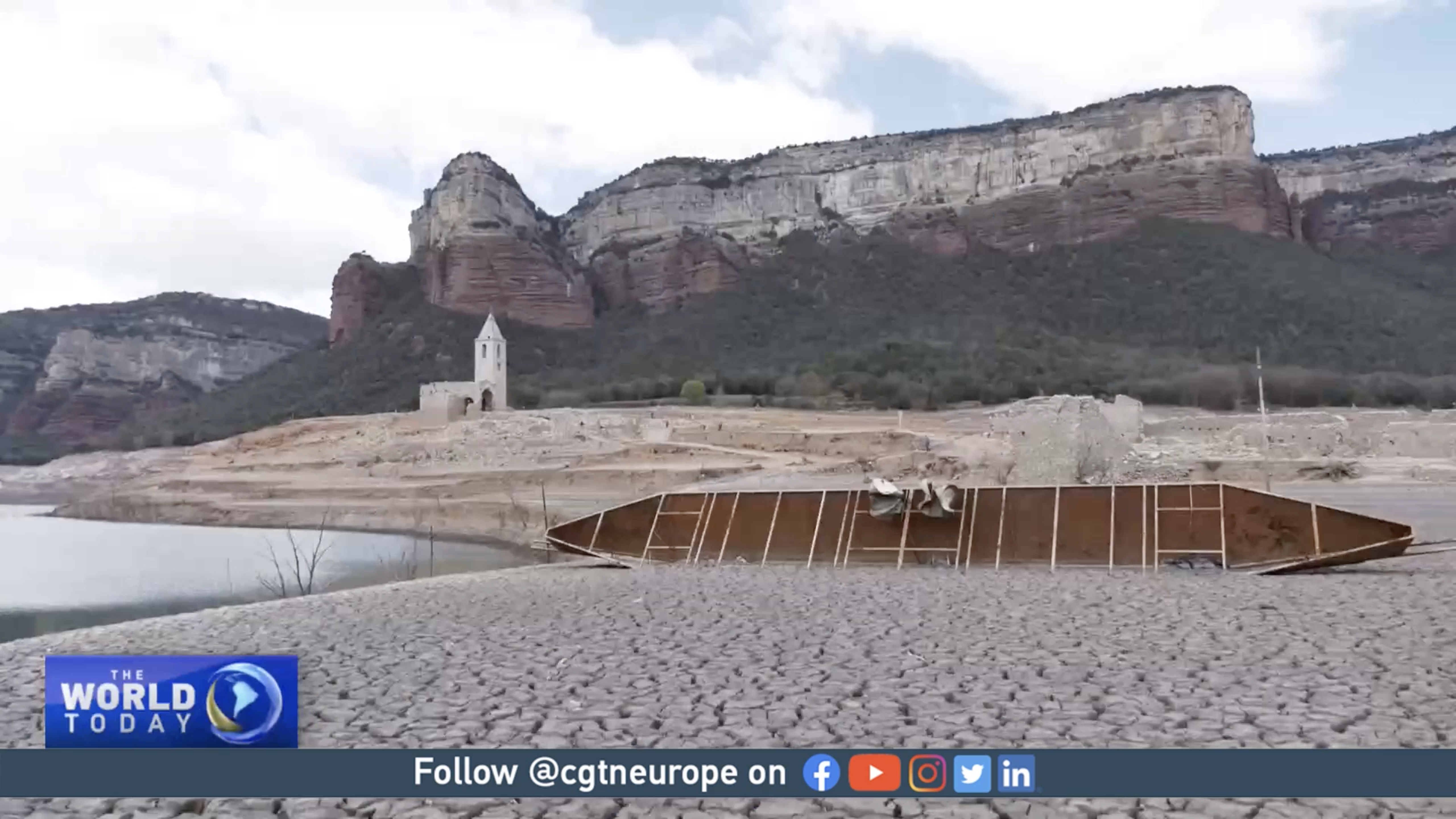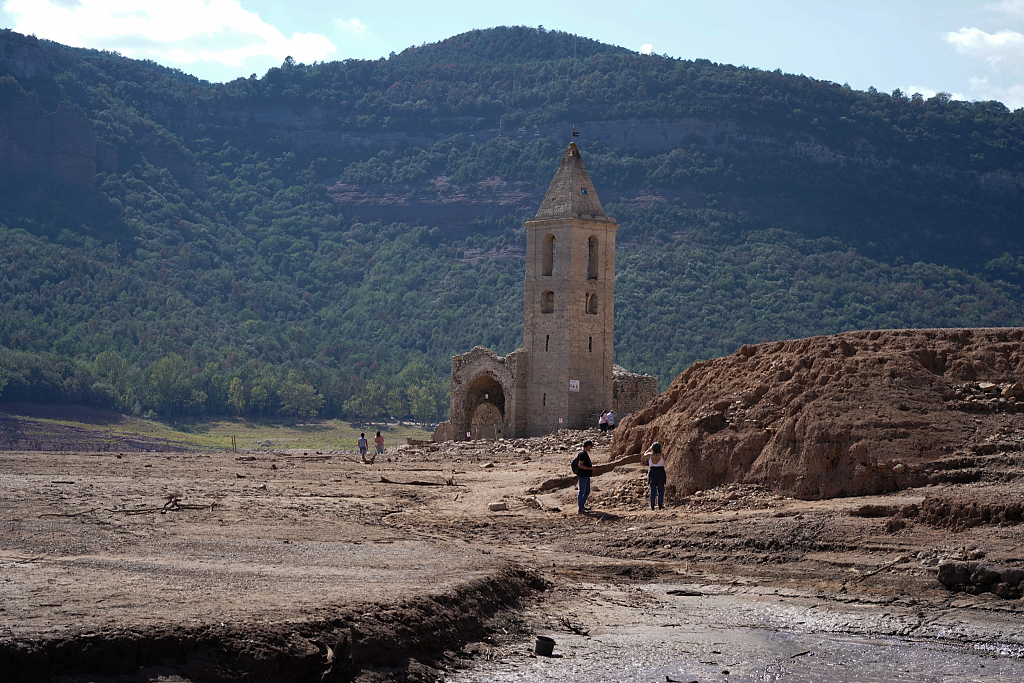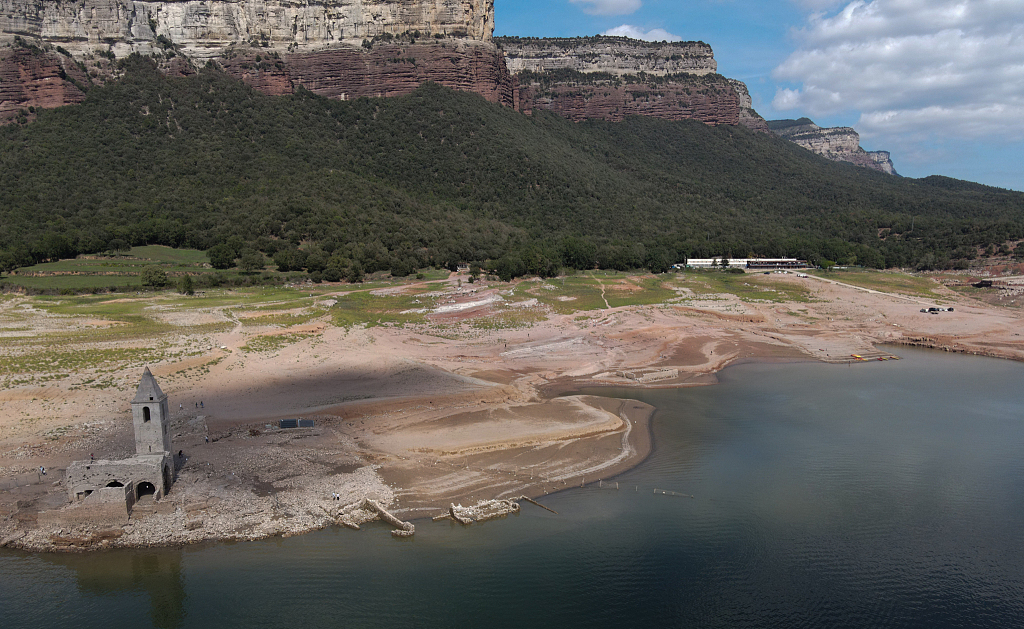02:56

Images of the thousand-year-old church of Sant Roma went viral when it emerged from the depths of the Sau reservoir thanks to Catalonia's prolonged drought. A haunting apparition from the past, it's an ominous warning for the future, the church a very visible symbol of the global climate emergency.
Submerged in the 1960s when the reservoir was flooded, the church now lies completely exposed to the baking sun, surrounded by the dried, cracked earth bed of what was once the reservoir.
READ MORE
Spain's new drought measures threaten mass job losses
'Spanish Stonehenge' emerges from drought-hit reservoir
Experts alarmed as Spain's first wildfire of 2023 comes early
The church has now become a tourist attraction and people mill about in the dry dust and sand taking photos and selfies. But while visitors snap away, the locals are devastated by what's happening.
"I'm an ecologist, I cry when I see what's happened here," Juan Canal Codina tells CGTN Europe as he walks along the dried-up reservoir bed. "I'm a child of nature, a part of nature. Us humans are supposed to be the rational ones in the animal kingdom."

The thousand-year-old church of Sant Roma went viral when it emerged from the Sau reservoir after Catalonia's prolonged drought. /CFP
The thousand-year-old church of Sant Roma went viral when it emerged from the Sau reservoir after Catalonia's prolonged drought. /CFP
He's walking with Paula Vinchi who grew up in Vilanova de Sau, the town right next to the reservoir. She grew up playing, swimming, boating, and kayaking in the Sau reservoir every summer.
"In the end, water is necessary and there are a lot of companies here who depend on it," she tells CGTN. "Like the guys who rent the kayaks, so many people come here in the summer, and seeing it like this is really sad."
50 tonnes of fish potentially at risk
fast approaching its three-year anniversary, the drought has left the reservoir near empty – at around seven percent capacity – and Catalan officials now consider it a lost cause. They are pumping the remaining water to the nearby Susqueda reservoir. But there are serious concerns about the quality of the water.
An estimated 40 to 50 tonnes of fish are at risk as the Sau water level dwindles. The reservoir is home to various native, tropical, and invasive species.
Local fishermen were brought in to remove 1,000 kilos a day of invasive species – a reported target of around 15 tonnes in total – but things haven't gone to plan.
"In the last three weeks we have tried to accelerate the transfer of water from the Sau reservoir to the connected Susqueda reservoir – they are connected and supply water to Barcelona," the Catalan Water Agency ACA said in a news conference.
"We have brought some fishing vessels to fish the different invasive fish that could live there, like catfish for example, because we are really worried about the quality of the water… the ammonia and the lack of oxygen."
Fishing boats on standby in case of mass die-off
An official onsite at the Sau reservoir, who preferred to remain anonymous, spoke to CGTN Europe about the issue.
They explained that the fishing plan failed because there were too many obstacles and places for the fish to hide, including fallen trees.

An estimated 40 to 50 tonnes of fish are at risk at the Sau resevoir. /CFP
An estimated 40 to 50 tonnes of fish are at risk at the Sau resevoir. /CFP
They added that unseasonably warm temperatures mean the water is also warmer, meaning the fish are less active. That makes them harder to catch.
The source added that just two tonnes of the 15-tonne target of fish had been removed from the Sau.
The fishing vessels now lie idle on the water, on standby in case of a potential mass die-off which would spell an ecological disaster.
Water restrictions placed on over six million people
Since February 2023, water restrictions have been in place limiting each person to 230-250 liters of water a day. There has also been a 40 percent cut to agricultural use, and 15 percent to industry.
Watering private gardens and public parks has also been banned, and new measures are being considered, like a reduction in water pressure, and even cuts at certain times during the day.
The restrictions affect six million people across Catalonia, including Barcelona and Girona.
"In Spain we live in a country where water is a scarce resource," Ruben Del Campo from AEMET, Spain's Meteorological Agency, says over Zoom.
"Water management is a challenge because of our geographical situation, and climate change is complicating things further with higher temperatures, less rain, and more evaporation," he adds.
"But everyone can contribute with responsible consumption at home and at work."
Every liter of water counts, and there is no magic solution, says Del Campo. Desalination, lower consumption, better treatment, management and reuse of water are all necessary.
Management of the infrastructure and investment are sorely needed in areas around Catalonia with hundreds of thousands of litres of fresh water lost every day to leaks and maintenance problems.
In an age of greater water scarcity, people also now have a more important part to play than ever.
Subscribe to Storyboard: A weekly newsletter bringing you the best of CGTN every Friday